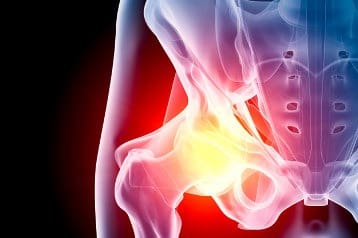The aim of a hip replacement is to alleviate pain and restore function in the hip joint. For some people with arthritis, hip replacement surgery could mean the difference between leading a normal life or putting up with a debilitating condition.
What is a hip replacement?
A hip replacement involves a surgical procedure to replace part or all of a diseased or damaged hip joint with an artificial substitute — a prosthetic hip joint. The operation to replace or mend a joint is known as ‘arthroplasty’.
When is a hip replacement necessary?
A hip replacement may become necessary if your hip joint is damaged as a result of disease or injury and other treatments have not been effective in treating pain and improving mobility.
Hip replacement surgery may be recommended for:
- osteoarthritis (the condition most commonly treated with hip replacement);
- rheumatoid arthritis; or
- post-traumatic arthritis due to a hip injury or fracture.
Hip replacements may not be recommended for people who have a high likelihood of injury, such as people with Parkinson’s disease or a significant weakness of the muscles.
What does a hip replacement involve?
Hip replacement surgery usually takes between 2 and 3 hours, and can be performed under general anaesthetic, where you will be completely sedated, or under a spinal anaesthetic, where you will be numb from the waist down.
A complete hip replacement involves substituting the ‘ball and socket’ of the hip joint — the acetabulum (socket shaped area in the pelvis) and the ball-shaped end of the femur (thigh bone) — with the prosthetic hip joint.
The surgeon will remove the diseased or damaged areas of the hip and leave the healthy parts in place. The artificial ‘ball’ is attached to a shaft and the shaft or stem is inserted into the top third of the thigh bone. The artificial socket fits into the pelvis. The prosthetic joint may be made from metal, plastic or ceramic components.
The surgeon may use a special glue or cement to attach the new parts of your hip to healthy bone (cemented prosthesis). Alternatively, the artificial parts of your new hip joint are made of a porous material that allows your natural bone to grow into the pores (uncemented prosthesis).
Recovery
After a hip replacement, you will usually remain in hospital for about a week, depending on your progress, mobility and ability to handle everyday activities. However, full recovery may take months.
Most doctors will encourage walking with the aid of a frame or crutches one, 2 or 3 days after the operation, depending on your age, muscle strength and general health.
A physiotherapist or other health care professional can help you adjust to your new hip joint by teaching you exercises to aid your recovery and increase your mobility. If you feel you may have difficulty around the home with everyday tasks, an occupational therapist can advise on aids and equipment to help you maintain your independence, for example, you could obtain tong-like reachers to grab things while bending to avoid putting strain on the hip.
If you have had a hip replacement, you should not cross your legs, turn your leg inward, or pull your knees up to your chest, to avoid dislodging/dislocating the new hip joint. You should also always sit on elevated chairs, and install and use an elevated toilet seat — your physiotherapist or occupational therapist can show you the appropriate heights. You should avoid bending over from the hips (for example when tying shoelaces) and you may also need advice on the most appropriate sleeping position.
If your operation and recovery are successful, you should be able to resume driving after about 4-6 weeks, and sexual activity after about 8 weeks.
When exercising, avoid sports that involve hard surfaces that may jar your new hip joint, such as tennis. Try walking, cycling or swimming instead.
Complications
There is a small possibility of hip dislocation in the first few months following hip replacement surgery.
Prosthetic hip joints can wear out over time, so if you have a hip replacement when you are still young and active, you may need a second hip replacement. However, hip replacements are lasting longer with the use of new materials, and can last for 25 years or more. A hip replacement may be replaced in a revision procedure that is relatively simple if there is no infection in the joint.
Infections of the surgical wound or the hip joint are possible complications of hip replacement surgery. Generally, infection of the hip joint occurs in less than 2 per cent of hip replacement procedures.
Another complication of hip replacement surgery is blood clots in the legs. Your surgeon will provide you with a programme designed to prevent blood clots, which usually includes anticoagulant therapy for a period of time after hip replacement surgery.
Talk to your doctor
Talk to your doctor or health care professional about any concerns you have about having your hip replaced. They will be able to advise you on whether the surgery is necessary for you, and on alternatives you may wish to explore.





